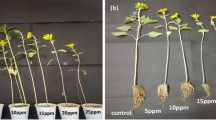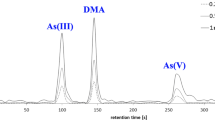Abstract
Wilting, especially of the leaves, was observed as an initial symptom of arsenate [As(V)] to Ludwigia octovalvis (Jacq.) P. H. Raven. The plants tolerated As(V) levels of 39 mg kg−1 for as long as 35 days of exposure. After 91 days, the maximum concentration of As uptake in the plant occurred at As(V) concentration of 65 mg kg−1 while As concentration in the stems, roots and leaves were 6139.9 ± 829.5, 1284.5 ± 242.9 and 1126.1 ± 117.2 mg kg−1, respectively. In conclusion, As(V) could cause toxic effects in L. octovalvis and the plants could uptake and accumulate As in plant tissues.





Similar content being viewed by others
References
ATSDR (2007) Toxicological profile for arsenic. Public Health Service Agency for Toxic Substances and Disease Registry, U.S. Department of Health and Human Services
Barber SA (1984) Soil Nutrient bioavaibility a mechanistic approach. John Willey and Sons, Inc
Bondada BR, Ma LQ (2003) Chapter 28: Tolerance of heavy metals in vascular plants: arsenic hyperaccumulation by Chinese, Brake Fern (Pteris vittata L.). In: Chandra S, Srivastava M, (eds) Pteridology In The New Millennium, Kluwer Academic Publishers, p 397–420
Concenco G, Galon L (2011) Plasmodesmata: symplastic transport of herbicides within the plants. In: Larramendy, M (eds) Herbicides, Theory and Applications, p 455–470, In Tech
Dahmani-Muller H, van Oort F, Gelie B, Balabane M (2000) Strategies of heavy metal uptake by three plant species growing near a metal smelter. Environ Pollut 109:231–238
Department of Environment, Malaysia (Jabatan Alam Sekitar, Malaysia) (2009) Contaminated Land Management and Control Guidelines No. 1: Malaysian Recommended Site Screening Levels for Contaminated Land, Malaysia
Gonzaga MIS, Santos JAG, Ma LQ (2006) Arsenic phytoextraction and hyper-accumulation by fern species. Sci Agric (Piracicaba, Braz) 63(1):90–101
ISO 11269-2 (1995) Soil quality—determination of the effects of pollutants on soil flora—effects of chemicals on the emergence and growth of higher plants
Kabata AP, Pendias H (2001) Trace elements in soils and plants, 3rd edn. CRC Press, Boca Raton
Kalra YP (1998) Handbook of references method for plant analysis. CRC Press, Boca Rotan
Nicholson, HC (2002) Arsenic in plants important to two Yukon first nations: impacts of gold mining and reclamation practices. MERG (Mining Environment Research Group) reports
OECD, Organization for economic co-operation and development (1984) guidelines for testing of chemicals 208, Terrestrial Plants, Growth Test
Pathan AK, Bond J, Gaskin RE (2008) Sample preparation for scanning electron microscopy of plant surfaces—Horses for courses. Micron 39(8):1049–1061
Quaghebeur M, Rengel Z (2003) The distribution of arsenate and arsenite in shoots and roots of Holcus lanatus is influenced by arsenic tolerance and arsenate and phosphate supply. Plant Physiol 132:1600–1609
Quaghebeur M, Rengel Z (2005) Arsenic speciation governs arsenic uptake and transport in terrestrial plant. Microchim Acta 151:141–152
Quevauviller PH (1998) Methodologies in soil and sediment fractionation studies, single and sequential extraction procedures. Royal Society of Chemistry, UK
Rahman A, Amelia A, Nazri A, Mushrifah I, Ahmad NS, Soffian JA (2009) Screening of Plants Grown in Petrosludge-A Preliminary Study towards Toxicity Testing in Phytoremediation. Colloquium on UKM—PRSB Phytoremediation, Malaysia, August
Rattanawat C, Rujira S, Narupot P, Maleeya K, Prayad P (2011) Effect of soil amendments on growth and metal uptake by Ocimum gratissimum grown in Cd/Zn-contaminated soil. Water Air Soil Pollut 214:383–392
Smith E, Naidu R, Alston AM (1998) Arsenic in The Soil Environment: A Review. Academic Press
Titah HS, Abdullah SRS, Anuar N, Idris M, Basri H, Mukhlisin M (2012) Arsenic range finding phytotoxicity test against Ludwigia octovalvis as first step in phytoremediation. Res J Environ Toxicol 6(4):151–159
USEPA (1996) SW 846: Method 3050B—acid digestion of sediments. Sludge and Soils, Rev 2
Zhang W, Cai Y, Tu C, Ma LQ (2002) Arsenic speciation and distribution in an arsenic hyper accumulator plant. Sci Total Environ 300:167–177
Acknowledgments
The authors would like to thank Tasik Chini Research, Universiti Kebangsaan Malaysia (UKM) and Ministry of Higher Education, Malaysia of UKM-KK-03-FRGS 0119-2010 for funding this research, and the Ministry of National Education of the Republic of Indonesia for providing the scholarship for the first author.
Author information
Authors and Affiliations
Corresponding author
Rights and permissions
About this article
Cite this article
Titah, H.S., Abdullah, S.R.S., Mushrifah, I. et al. Arsenic Toxicity on Ludwigia octovalvis in Spiked Sand. Bull Environ Contam Toxicol 90, 714–719 (2013). https://doi.org/10.1007/s00128-013-0996-5
Received:
Accepted:
Published:
Issue Date:
DOI: https://doi.org/10.1007/s00128-013-0996-5




